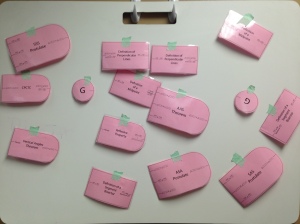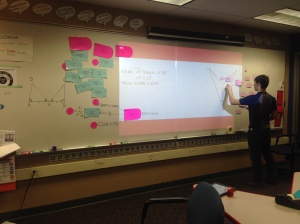I’ve tried to explain why AngLegs are a must have for high school geometry and should not only be considered a tool for younger students. Here is an example of how I find them indispensable in teaching triangle congruence. This lesson is adapted from MARS: Evaluating Conditions for Congruency.
“Ok class, you are sitting in pairs and at each table is a bag of AngLegs. On the board I have written the question we are trying to answer for each of the scenarios I will present.”
“I made a triangle that includes a blue AngLeg. Can you make a different triangle that also has a blue AngLeg?”
“Make one. Hold it up.”
“How do you know that these triangles are different?”
“So, you are saying that keeping one side the same does not mean that the triangles must be congruent.”
Next, lets look at Card 3:

“I made a triangle out of a blue, a purple and a yellow AngLeg. Can you make a different triangle using the same three AngLegs?”
“What if you put them in a different order? …or move the purple between the blue and the yellow? Are you sure they have to be the same? How can you tell?”
Student: “The triangles still fit perfectly on top of each other”.
Student: “If the three sides on one triangle are the same as three sides of another triangle, then the triangles must be the same.”
Look at Card 7:
 “How can you tell if an angle is the same in two different triangles?”
“How can you tell if an angle is the same in two different triangles?”
Student: “They fit perfectly on top of each other!”
“Is there a way to make these triangles so that they are not congruent?”
Student: “No way. These have to be the same”
Student: “Wait! I made two different triangles with all three angles the same and one side the same.” Does this count? Look!”
Student:”If two angles are the same, then the third angle always has to be the same because they add up to 180 degrees!”
“So what is the conclusion for this one?”
Student:”The triangles can still be different sizes, but their angles are all the same.”
“For the remainder of this class period, individually analyze card 5 and any other card, so 2 additional cards. Take good notes and write down your conclusions for tomorrow, where you will be randomly assigned a partner to complete the triangle activity. ”
From here the lesson continues as described in the SHELL center teacher guide linked above and described further in a blog post here.
Removing the hurdle of constructions allows students to focus on the learning goal for this activity: determining the minimum information required to guarantee triangle congruence, and what congruence means. It also connects nicely to congruence proofs through transformations as students are physically checking of the triangles fit on top of each other.



















